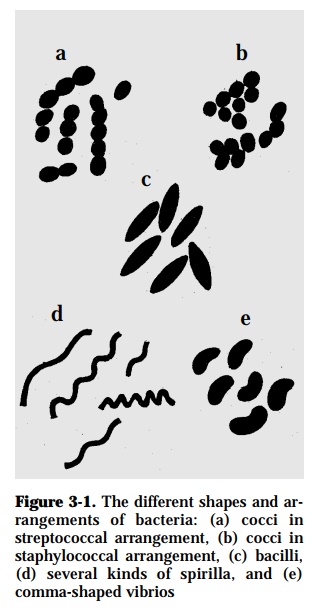Chapter: Health Management in Aquaculture: Bacterial diseases
What are Bacteria?
WHAT ARE BACTERIA?
Bacteria are not visible to the naked eye. These microorganisms are of very small dimensions, usually between 0.5 and 10 microns (µm). But, when bacte-ria multiply in great numbers on a solid medium, they form visible colonies representing millions or billions of individual cells. The cells can be seen only under a microscope from a smear stained with a dye on a microscope slide.
Bacteria differ from other cells in that they are prokaryotic (lacking a nuclear membrane). The nucleus occupies the center of the cell. All its genetic material is linked in a single chromosome. The cytoplasm is densely packed with RNA and is finely granular because of the presence of ribosome. The nucleus/ cyto-plasm complex is packaged in a complex envelope or integument. Its inner-most layer is the thin cytoplasmic membrane (plasmalemma). Outside the membrane is a rigid cell wall. Some bacterial pathogens develop a capsule out-side of the cell wall, which is usually associated with the virulence or infective ability of the organism. Many of the pathogenic bacteria are flagellated and a few have no flagella for locomotion. Some move by body flexing or gliding.

Some bacteria produce enzymes called extracellular products or ECP, which are associated with the microorganism’s virulence. Extracellular products are highly toxic to fish and crustaceans and they contain proteases, hemolysins, exohemagglutinins and cytotoxins.
Bacteria reproduce asexually by binary fission. That is, they multiply by an elongation of the cell followed by a division.
The most common method used to detect the presence of bacteria is by gram stain. The gram stain classifies bacteria into two groups: the gram positive and the gram negative. Gram-positive bacteria are those that possess a thick pepti-doglycan cell wall which will retain the initial crystal violet stain during wash-ing with 95% alcohol. Gram-negative bacteria are those that possess a uni-molecular peptidoglycan cell wall bounded on one side by the cytoplasmic membrane and on the other side by the outer membrane; such cells are decol-orized by 95% alcohol and take up the secondary stain. To identify bacterium, a pure culture should be obtained, containing a single species and not a mix-ture of different kinds of bacteria.
In classifying bacteria, one needs to pay attention to the cell shape. There are three distinct cell forms: cocci, baccili and spiral (Fig.3-1). Cocci are spherical cells and exist in several patterns or groupings which are specific to the genus. Paired cocci are called diplococcus, while those in long chains are called strep-tococcus. Irregularly grouped cocci are called staphylococcus. Longer and cy-lindrical bacteria are known as bacilli or rods. Cells that are between the coc-cus and the bacillus in shape are called coccobacilli. The short, curved rods are the vibrios. When more than one curvature is observed, it is called spirilla. Most bacteria that cause disease in fish and crustaceans are rod-shaped. Figure 3-1 shows the different shapes and arrangements of bacteria.
The shape, size and color of a given colony are also important in identification. The bacterial colony surface texture, whether rough, smooth or mucoid, should also be observed. The same species can form rough or smooth colonies, de-pending on environmental conditions and the virulence or infective ability of the strain. Smoother colonies are often more virulent or harmful. Considering the large number of bacteria known to exist, gram stain reaction and morpho-logical form are not enough to identify bacterial species. To identify a bacte-rium, the different physiological or bodily and biochemical properties it pos-sesses must first be known through a series of tests.
Related Topics